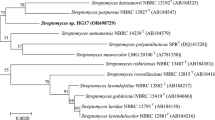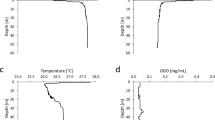Abstract
A novel isolate belonging to the genus Streptomyces, strain SL-4T, was isolated from soil sample collected from a sanitary landfill, New Delhi, India. The taxonomic status of this isolate was studied by polyphasic approach including morphological, physiological and chemo-taxonomic characterization. Spore chains of SL-4T were open loops, hooks or extended spirals of wide diameter (retinaculiperti). The cell wall peptidoglycan of the isolate SL-4T contained L,L-diaminopimelic acid, suggesting that the strain has a cell wall of chemotype-I. The polar lipid profile of the isolate was of Type II, with phosphatidylglycerol, phosphatidylethanolamine, phosphatidylinositol and phosphatidylinositol mannosides. The 16SrRNA gene sequence similarity between SL-4T and its phylogenetic relatives Streptomyces atrovirens NRRLB 16357 T (DQ026672), S. albogriseolus NRRLB 1305 T (AJ494865), S viridodiastaticus NBRC 13106 T (AB184317), S. caelestis NRRL 2418 T (X80824), S. flavoviridis NBRC 12772 T (AB184842), S. pilosus NBRC 12807 T (AB184161) and S. longispororuber NBRC 13488 T (AB184440) was 99.65, 99.65, 99.64, 99.23, 99.15, 99.14 and 99.13 % respectively. Subsequent DNA–DNA hybridization experiments with the test strain and its clade members showed 55.27, 44.27, 36.86, and 15.65 % relatedness between SL-4T and its relatives S. atrovirens, S. albogriseolus, S. viridodiastaticus and S. longispororuber respectively. The genotypic and phenotypic data was analyzed to verify possibility of the isolate SL-4T representing novel member of the genus Streptomyces, for which the name S. antibioticalis is being proposed. The type strain is SL-4T (=CCM 7434T=MTCC 8588T).






Similar content being viewed by others
References
Pathma J, Rahul GR, Kennedy R, Kamaraj, Subashri R, Sakthivel N (2011) Secondary metabolite production by bacterial antagonists. J Biol Control 25:165–181
Bull AT (2004) Microbial Diversity and Biosprospecting. American Society for Microbiology Press, Washington
Solanki R, Khanna M, Lal R (2008) Bioactive compounds from marine actinomycetes. Indian J Microbiol 48:410–431
Watve MS, Tckoo R, Jog MM, Bhole BD (2001) How many antibiotics are produced by the genus Streptomyces? Arch Microbiol 176:386–390
Williams ST, Goodfellow M, Alderson G (1989) Genus Streptomyces Waksman and Henrici 1943, 339AL. In: Williams ST, Sharpe ME Holt JG (eds) Bergey’s manual of systematic bacteriology, vol 4. Williams & Wilkins, Baltimore, pp 2452–2492
Anderson AS, Wellington EMH (2001) The taxonomy of Streptomyces and related genera. Int J Syst Evol Microbiol 48:407–417
Prakash O, Verma M, Sharma P, Kumar M, Kumari K, Singh A, Kumari H, Jit S, Gupta SK, Khanna M, Lal R (2007) Polyphasic approach of bacterial classification—an overview of recent advances. Indian J Microbiol 47:98–108
Shirling EB, Gottlieb D (1966) Methods for characterization of Streptomyces species. Int J Syst Bacteriol 16:313–340
Kates M (1972) In: Work TS, Work E (eds) Techniques in lipidology, Elsevier, New York, p 351
Staneck JL, Roberts GD (1974) Simplified approach to identification of aerobic actinomycetes by thin layer chromatography. Appl Environ Microbiol 28:226–231
Miller LT (1982) Single derivatization method for routine analysis of bacterial whole-cell fatty acid methyl esters, including hydroxyl acids. J Clin Microbiol 16:584–586
Kuykendall LD, Roy MA, O’Neill JJ, Devine TE (1988) Fatty acids, antibiotic resistance and deoxyribonucleic acid homology groups of Bradyrhizobium japonicum. Int J Syst Bacteriol 38:358–361
Lancini G, Parenti F (1982) Antibiotics: An integrated view. In: Starr MP (ed), Springer, New York, pp 1–241
Solanki R, Lal R, Khanna M (2011) Antimicrobial activities of actinomycetes from diverse ecological habitats in Delhi and its adjoining states, India. J Microb World 13:233–240
Andrews JM (2001) Determination of minimum inhibitory concentrations. J Antimicrob Chemother 48(Suppl 1):5–16
Khanna M, Solanki R, Lal R (2011) Bioactive compounds from soil actinomycetes, Chapter 6. In: Biodiversity, biotechnology and man: interdependence and future challenges, Biotech Books, New Delhi, pp 92–108
Lal R, Lal S, Gründ E, Eichenlaub R (1991) Construction of a hybrid plasmid capable of replication in Amycolatopsis mediterranei. Appl Environ Microbiol 57:665–671
Chun J, Lee JH, Jung Y, Kim M, Kim S, Kim BK, Lim YW (2007) EzTaxon: a web-based tool for the identification of prokaryotes based on 16S ribosomal RNA gene sequences. Int J Syst Evol Microbiol 57:2259–2261
Saitou N, Nei M (1987) The Neighbour-joining method: a new method for reconstructing phylogenetic trees. Mol Biol Evol 4:406–425
Thompson JD, Gibson TJ, Plewniak F, Jeanmougin F, Higgins SG (1997) The CLUSTAL_X windows interface: flexible strategies for multiple sequence alignment aided by quality analysis tools. Nucl Acids Res 25:4876–4882
Tamura K, Dudley J, Nei M, Kumar S (2007) MEGA 4: molecular evolutionary genetics analysis (MEGA) software version 4.0. Mol Biol Evol 24:1596–1599
Fitch WM (1971) Towards defining the course of evolution: minimum change for a specific tree topology. Syst Zool 20:406–416
Kumari K, Sharma P, Tyagi K, Lal R (2011) Pseudoxanthomonas indica sp. nov., isolated from Hexachlorocyclohexane (HCH) dumpsite in North India. Int J Syst Evol Microbiol 61:2107–2111
Kaur J, Verma M, Lal R (2011) Rhizobium rosettiformans sp. nov., isolated from hexachlorocyclohexane (HCH) dump site in India, and reclassification of [Blastobacter] aggregatus Hirsch et al. [1985] as Rhizobium aggregatum comb. nov. Int J Syst Evol Microbiol 61:1218–1225
Malhotra J, Anand S, Jindal S, Raman R, Lal R (2012) Acinetobacter indicus sp. nov., isolated from hexachlorocyclohexane (HCH) dumpsite. Int J Syst Evol Microbiol. doi:10.1099/ijs.0.037721-0
Bala S, Khanna R, Dadhwal M, Prabagaram SR, Shivaji S, Cullum J, Lal R (2004) Reclassification of Amycolatopsis mediterranaei DSM 46095 as Amycolatopsis rifamycinica sp. nov. Int J Syst Evol Microbiol 54:1145–1149
Tourova TP, Antonov AS (1987) Identification of microorganisms by rapid DNA–DNA hybridization. Methods Microbiol 19:333–355
Khanna M, Solanki R, Lal R (2011) Selective isolation of rare actinomycetes producing novel antimicrobial compounds. Int J Adv Biotechnol Res 2:357–375
Labeda DP (1996) DNA relatedness among verticil forming Streptomyces species (formerly Streptoverticillium species). Int J Syst Bacteriol 46:699–703
Labeda DP (1993) DNA relatedness among strains of the Streptomyces lavendulae phenotypic cluster group. Int J Syst Bacteriol 43:822–825
Acknowledgments
This work was supported by grants from Ministry of Environment and Forests (MOEF), Government of India. RS acknowledges CSIR (Council of Scientific and Industrial Research), Government of India, for providing the Senior research fellowship. Infrastructural facilities provided by Acharya Narendra Dev College are gratefully acknowledged. We would like to thank J. P. Euzèby for etymological advice.
Author information
Authors and Affiliations
Corresponding author
Rights and permissions
About this article
Cite this article
Khanna, M., Solanki, R. Streptomyces antibioticalis, a Novel Species from a Sanitary Landfill Soil. Indian J Microbiol 52, 605–611 (2012). https://doi.org/10.1007/s12088-012-0309-4
Received:
Accepted:
Published:
Issue Date:
DOI: https://doi.org/10.1007/s12088-012-0309-4




